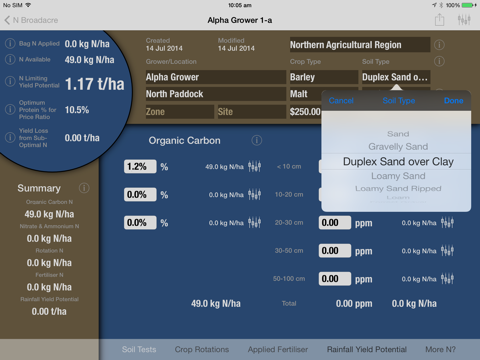
The COGGO N Broadacre App for iPad is a powerful and flexible Nitrogen model for wheat, barley and canola. N Broadacre is an independent model and therefore can be used with any soil test data regardless of where you buy your fertiliser. N Broadacre calculates the amount of nitrogen available to crops from the various nitrogen pools in the soil. From this N Broadacre calculates how much nitrogen is required to reach the yield/protein target of the crop. N Broadacre is designed by agronomists for agronomists, farmers, consultants and researchers alike. N Broadacre is derived from hundreds of nitrogen field trials and is endorsed by the Department of Agriculture and Food in Western Australia.
Key Features:
• Exceptionally easy to use. Helpful on-screen notes to explain outputs and guide the user.
• Only basic soil test data required to run the model (Soil Organic Carbon% and Nitrate and Ammonium test results).
• N Broadacre is a highly flexible model. Other information taken into account to calculate a nitrogen rate include fertiliser already applied, rotational history, soil type, gravel content, depth to duplex layers, fertiliser type, crop type and delivery segregation.
• GM and non GM canola nitrogen efficiency accounted for.
• Economics of the fertiliser price vs the grain price accounted for with every nitrogen recommendation.
• A simple yield calculator is included with the model. Alternatively, outputs from yield probability models such as yield prophet can be used in N Broadacre.
• Ability to vary key nitrogen sources (via sliders) to account for changes in seasonal conditions such as summer rain or high nitrogen leaching events.
• Runs of N Broadacre can be saved via screenshot and emailed easily to clients or for record keeping purposes.
• N Broadacre is ground truthed for Western Australian soils and rainfall. There is no reason why N Broadacre would not work in other dryland temperate agricultural regions throughout Australia and the world between latitudes of 27-37 degrees. We are happy to ground truth this model for other agricultural regions.



